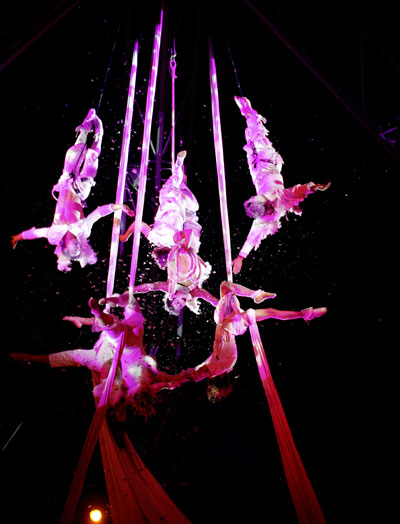 New Delhi:
New Delhi: The circus is reinventing itself to keep its human feats alive the world over with more stylised contemporary acts.
A trapeze theatre from France, "Flying Angels" by Les Studio De Cirque, that is touring India as part of the closing ceremony of "Bonjour India - Festival of France", is showcasing the new-age western circus that combines trapeze and aerial stunts with the contemporary theatrical tradition and powerful storyboards.
The act - a tale about angels returning to earth after 500 years on white horses to shower joy on people and collect one of their mates whom they had left behind - is one of the biggest French-Latino circus performance that has done away with animals and landscape-oriented traditions with abstract performance props.
"Trapeze theatre is a mixing of the classical discipline, trapeze, acrobatic rope tricks and different kinds of suspending aerial acts. It is an experience in climbing techniques," stage director of "Flying Angel" Stephan Girard told in the capital between his rehearsals at the Jawaharlal Nehru Stadium, the venue of his March 31 signature 2001 new age circus.
The artists use tons of white feathers to create the impressions of snow, angels wings and divine blessings that in an abstract white magical world connect heaven with earth.
The show, created after Girard and two of mates, Pierrot Bidon and Ana Rache, return from a performance in Brazil, is described as "manifest of a quest to take conventional circus out of its usual environment to create unexpected genres".
The circus changed its mindset in the years between 1980-1990 when acrobat Bidon took it out of the tent and infused it with components of theatre - body language, voices, dialogues, cinematic effects and images - to make it an avant garde public performance, Girard said.
Till then, traditional circuses all over the world were using horses and animals. "But Bidon made it became more of the street show - a combination of the motorcycle-truck violence with the positive experience of rock n' roll in the 1990s. He created what came to be known as 'archaos circus' - or the circus of the chaos," Girard said.
The chaos circus, without animals, included dangerous stunts like chainsaw juggling, fire breathing and a wall of death. It found a large following in Europe in the 1990s.
Another contemporary circus that made entertainment headlines in the west was the Cirque du Soleil or the Circus of the Sun - a Canadian-French performance that combined trapeze act with abstract architecture, world class acrobatics, divers, swimmers, clowns and dancers to create stories from fables and the march of modern civilisation in an act using the the concept of "celestial beings trapezing down to earth from heaven to narrate an opera tale about creation and love".
"Three more acts - Theatre Zingaro Equestre (France), Le Cirque Eloize (Canada) and Cirkus Cirkor (Sweden) - have taken circus out of its conventional matrix into complex trapeze and performance acts," Girard said.
Theatre Zingaro Equestre, formed in 1984, carried the traditional French horsemanship meant for circus entertainment to new theatrical level to explore the complex relationship between man and animal with narratives, dances, fantasy sequences and special light effects. In its production "Chimere", the theatre used "dusky women clad in Indian saris to resemble Oriental princesses who danced in rhythm with horses," Girard said.
Project Bandaloop from the US, which has performed at Indian venues like the Golconda Fort, the Mussoorie hills and the LIC Building in New Delhi uses circus trapeze, suspension walking and aerial dancing to raise awareness about environment and urban heritage.
The circus has changed its aesthetic idiom in Russia and China as well to move out of the animal ring with acrobatics and trapeze acts.
In India, however, it is a dying tradition because of its failure to move on with time. Ensembles like the Gemini Circus, Jumbo Circus, the Great Royal Circus, Great Bombay Circus, Rajkamal Circus and the Great Rayman Circus rarely pitch their tents. The outcry against use of animals and dwindling resources have also shrunk the troupes.
"But once upon a time, they had a wide following. We will love to work with Indian acrobats and performers if we get an opportunity," Girard said.
The troupe plans to meet clowns and performers during their stay in India.
 New Delhi: The circus is reinventing itself to keep its human feats alive the world over with more stylised contemporary acts.
New Delhi: The circus is reinventing itself to keep its human feats alive the world over with more stylised contemporary acts.